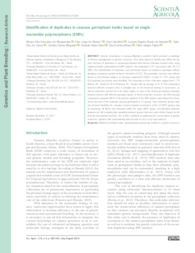Identification of duplicates in cassava germplasm banks based on single-nucleotide polymorphisms (SNPs).
Identification of duplicates in cassava germplasm banks based on single-nucleotide polymorphisms (SNPs).
Autoria: ALBUQUERQUE, H. Y. G. de; OLIVEIRA, E. J. de; BRITO, A. C.; ANDRADE, L. R. B. de; CARMO, C. D. do; MORGANTE, C. V.; VIEIRA, E. A.; CUNHA, E. F. M.; FALEIRO, F. G.
Resumo: Genetic redundancy in cassava (Manihot esculenta Crantz) presents a challenge to efficient management of genetic resources. This study aimed to identify and define the ge-netic structure of duplicates in cassava germplasm from various Embrapa research units, using single-nucleotide polymorphism (SNP) markers. We evaluated 2,371 accessions with 20,712 SNPs. The identification of duplicates was performed based on multilocus genotypes (MLG), adopting a maximum genetic distance threshold of 0.05. The population structure was defined based on discriminant analysis of principal components (DAPC). A total of 1,757 unique and 614 duplicate accessions were identified. The redundancy of the collections ranged from 17 % (Belém, PA ? Brazil) to 39 % (Petrolina, PE ? Brazil), with an average of 21 %. This redundancy between different research units is probably due to the historical sharing of accessions, as well as collections carried out in the same region, or even to the intense germplasm exchange between farmers with different genotype names. In terms of genetic structure, the 250 principal components explained 88 % of the genetic variation of the SNP markers and defined the hierar-chical structure of the duplicate cassava germplasm in 12 groups. Since heterotic groups have not yet been identified for cassava, crosses between accessions of the 12 DAPC groups may be promising. All MLGs were allocated within the same DAPC group, corroborating duplicate analyses yet still revealing high variability between groups that were quite distinct based on the first two discriminant functions. Our results contribute to optimizing the conservation of genetic resources, together with understanding diversity and its use in crop improvement.
Ano de publicação: 2019
Tipo de publicação: Artigo de periódico
Unidade: Embrapa Semiárido
Palavras-chave: Breeding, Breeding and Genetic Improvement, Cassava, Cultivo, Mandioca, Manihot Esculenta, Melhoramento Vegetal
Observações
1 - Por padrão são exibidas publicações dos últimos 20 anos. Para encontrar publicações mais antigas, configure o filtro ano de publicação, colocando o ano a partir do qual você deseja encontrar publicações. O filtro está na coluna da esquerda na busca acima.
2 - Para ler algumas publicações da Embrapa (apenas as que estão em formato ePub), é necessário ter, no celular ou computador, um desses softwares gratuitos. Sistemas Android: Google Play Livros; IOS: iBooks; Windows e Linux: software Calibre.
Acesse outras publicações
Acesse a Base de Dados da Pesquisa Agropecuária (BDPA) para consultar o acervo completo das bibliotecas da Embrapa.

